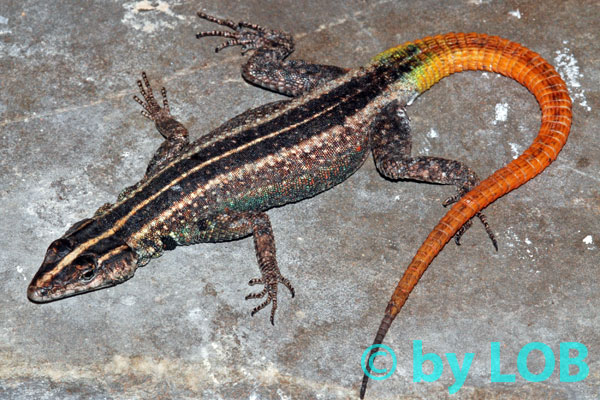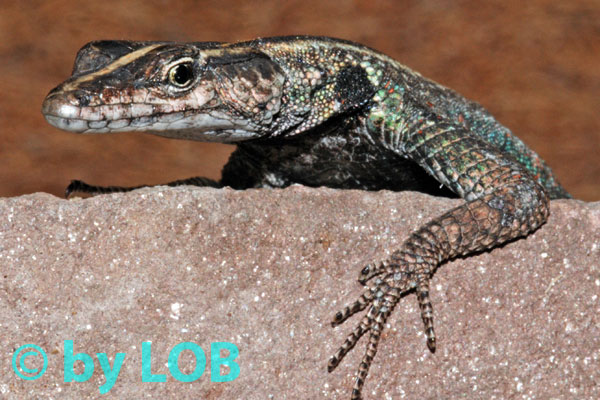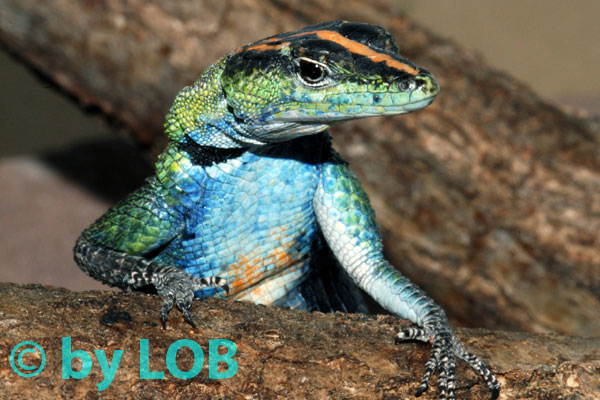
Platysaurus torquatus – PETERS, 1879

Platysaurus torquatus: Adult wild-caught male from Mozambique • Adultes Wildfangmännchen aus Mosambik
© Lutz Obelgönner
© Lutz Obelgönner

Platysaurus torquatus: Adult wild-caught female from Mozambique • Adultes Wildfangweibchen aus Mosambik
© Lutz Obelgönner
© Lutz Obelgönner
Collared Flat Lizard
Description
Art named after the Latin torquatus = 'with a necklace' referring to the collar around the neck, best visible on the males. The animals – among other types – are often sold commercially as Platysaurus janssoni (a non-existent species). Platysaurus torquatus is the only species in the complex where the males keep their bright central stripe on the back into adulthood. The breast is yellow or orange and blue towards the belly. The animals are rapid sprinters and jumpers, really easy to keep, but quite shy. As it is with all flat lizards there is no decent literature about captive care available.
Protection
none
Adult Size
to 16 cm
Lifespan
about twelve years
Distribution
northeastern Zimbabwe, Mozambique, Malawi
Habitat
temperate savannah, rocky areas usually near water courses
Captive Care
Cage of at least 100x50x60 cm WDH. The animals use the height, if appropriate structures are provided. Offer lots of rocks and crevices, keep at least one of them wet, for example by introducing sphagnum moss. Temperature 22–26 °C, 40 °C at a hot spot, at night 18–20 ° C, humidity 50–60%. Daylight fluorescent lamps or LEDs, HQL or HQI spot, water bowl, food bowl for worms etc., substrate of sand and clay mix or turf.
Food
Invertebrates and larvae, always enrich with vitamins and minerals (z. B. Herpetal Complete)
Reproduction / Breeding
With enough space even large groups possible. Sufficient hiding places and structure help to get a group working. Cooler phase (2 months at 15–16 ° C). Females lay two or more clutches between rocks in the summer, each with only two eggs. Without a wet crevice these dry out quickly. Raise juveniles separately with much UV light.
Art named after the Latin torquatus = 'with a necklace' referring to the collar around the neck, best visible on the males. The animals – among other types – are often sold commercially as Platysaurus janssoni (a non-existent species). Platysaurus torquatus is the only species in the complex where the males keep their bright central stripe on the back into adulthood. The breast is yellow or orange and blue towards the belly. The animals are rapid sprinters and jumpers, really easy to keep, but quite shy. As it is with all flat lizards there is no decent literature about captive care available.
Protection
none
Adult Size
to 16 cm
Lifespan
about twelve years
Distribution
northeastern Zimbabwe, Mozambique, Malawi
Habitat
temperate savannah, rocky areas usually near water courses
Captive Care
Cage of at least 100x50x60 cm WDH. The animals use the height, if appropriate structures are provided. Offer lots of rocks and crevices, keep at least one of them wet, for example by introducing sphagnum moss. Temperature 22–26 °C, 40 °C at a hot spot, at night 18–20 ° C, humidity 50–60%. Daylight fluorescent lamps or LEDs, HQL or HQI spot, water bowl, food bowl for worms etc., substrate of sand and clay mix or turf.
Food
Invertebrates and larvae, always enrich with vitamins and minerals (z. B. Herpetal Complete)
Reproduction / Breeding
With enough space even large groups possible. Sufficient hiding places and structure help to get a group working. Cooler phase (2 months at 15–16 ° C). Females lay two or more clutches between rocks in the summer, each with only two eggs. Without a wet crevice these dry out quickly. Raise juveniles separately with much UV light.
Halsband-Plattechse
Generelles
Art benannt nach dem Lateinischen torquatus = "mit einer Halskette geschmückt" wegen der deutlich ausgeprägten Schmuckzeichnung am Hals der Männchen. Die Tiere werden im Handel – wie einige andere auch – oft als Platysaurus janssoni (eine nicht-existente Art) verkauft. Die Männchen von Platysaurus torquatus behalten als einzige Art des Komplexes auch adult die hellen Mittelstreifen auf dem Rücken. Die Brust ist gelb oder orange und wird zum Bauch hin blau. Die Tiere sind rasante Renner und Springer, eigentlich einfach zu halten, aber recht scheu. Wie bei allen Plattechsen gibt es auch zu dieser Art keine brauchbare Literatur zur Haltung.
Schutzstatus
keiner
Größe
bis 16 cm
Lebenserwartung
etwa zwölf Jahre
Vorkommen
nordöstliches Zimbabwe, Mosambik, Malawi
Biotop
gemäßigte Savannenlandschaft, Felsflächen meist in der Nähe von Wasserläufen
Haltung
Terrariengröße mindestens 100x50x60 cm BTH. Die Tiere nutzen die Höhe, wenn entsprechende Strukturen angeboten werden. Viele Felsen und Spalten anbieten, mindestens eine davon feucht halten, z. B. Durch das Einbringen von Sphagnum. Temperatur 22–26 °C, Sonnenplatz 40 °C, nachts 18–20 °C, Luftfeuchtigkeit 50–60 %. Tageslichtleuchtstoffröhren oder LEDs, HQL- oder HQI-Spot, Wasserschale, Futterschale für Würmer etc. Substrat Sand-Lehm-Mix oder Rollrasen.
Futter
Wirbellose und Larven, immer mit Vitaminen und Mineralien versetzen (z. B. Herpetal Complete)
Fortpflanzung / Zucht
Bei ausreichend Platz auch große Gruppen möglich. Ausreichend Versteckplätze und Struktur im Becken helfen. Kühlere Phase (2 Monate bei 15–16 °C). Weibchen legen zwei oder mehr Gelege mit je nur zwei Eiern im Sommer zwischen Felsen. Ohne feuchte Spalte vertrocknen diese schnell. Jungtiere separat und mit viel UV-Licht aufziehen.
Art benannt nach dem Lateinischen torquatus = "mit einer Halskette geschmückt" wegen der deutlich ausgeprägten Schmuckzeichnung am Hals der Männchen. Die Tiere werden im Handel – wie einige andere auch – oft als Platysaurus janssoni (eine nicht-existente Art) verkauft. Die Männchen von Platysaurus torquatus behalten als einzige Art des Komplexes auch adult die hellen Mittelstreifen auf dem Rücken. Die Brust ist gelb oder orange und wird zum Bauch hin blau. Die Tiere sind rasante Renner und Springer, eigentlich einfach zu halten, aber recht scheu. Wie bei allen Plattechsen gibt es auch zu dieser Art keine brauchbare Literatur zur Haltung.
Schutzstatus
keiner
Größe
bis 16 cm
Lebenserwartung
etwa zwölf Jahre
Vorkommen
nordöstliches Zimbabwe, Mosambik, Malawi
Biotop
gemäßigte Savannenlandschaft, Felsflächen meist in der Nähe von Wasserläufen
Haltung
Terrariengröße mindestens 100x50x60 cm BTH. Die Tiere nutzen die Höhe, wenn entsprechende Strukturen angeboten werden. Viele Felsen und Spalten anbieten, mindestens eine davon feucht halten, z. B. Durch das Einbringen von Sphagnum. Temperatur 22–26 °C, Sonnenplatz 40 °C, nachts 18–20 °C, Luftfeuchtigkeit 50–60 %. Tageslichtleuchtstoffröhren oder LEDs, HQL- oder HQI-Spot, Wasserschale, Futterschale für Würmer etc. Substrat Sand-Lehm-Mix oder Rollrasen.
Futter
Wirbellose und Larven, immer mit Vitaminen und Mineralien versetzen (z. B. Herpetal Complete)
Fortpflanzung / Zucht
Bei ausreichend Platz auch große Gruppen möglich. Ausreichend Versteckplätze und Struktur im Becken helfen. Kühlere Phase (2 Monate bei 15–16 °C). Weibchen legen zwei oder mehr Gelege mit je nur zwei Eiern im Sommer zwischen Felsen. Ohne feuchte Spalte vertrocknen diese schnell. Jungtiere separat und mit viel UV-Licht aufziehen.
Literature / Literatur
Branch, B. (1998). Field Guid to the Snakes and other Reptiles of Southern Africa. Struik, Capetown.
Branch, B. (2001). A Photographic Guide to the Snakes and other Reptiles of Southern Africa. Struik, Capetown.
Broadley, D. G. (1978). A revision of the Genus Platysaurus A. Smith. Occ. Papers Nat. Museum south. Rhodesia, B, 6 (4): 129–185.
Branch, B. (1998). Field Guid to the Snakes and other Reptiles of Southern Africa. Struik, Capetown.
Branch, B. (2001). A Photographic Guide to the Snakes and other Reptiles of Southern Africa. Struik, Capetown.
Broadley, D. G. (1978). A revision of the Genus Platysaurus A. Smith. Occ. Papers Nat. Museum south. Rhodesia, B, 6 (4): 129–185.

Platysaurus torquatus: This close-up shows the collar around the neck of this male • Diese Nahaufnahme zeigt das ausgeprägte Halsband dieses Männchens.
© Lutz Obelgönner
© Lutz Obelgönner